|
HOME: www.hiltonpond.org |
|||
|
Photo by Hilda Flamholtz © Hilton Pond Center BIRD-BANDING, WARBLER-WATCHING, HAWK-GAWKING . . . AND SOME NATURE-NURTURING, TOO These first ten days of October have involved lots of time in the out-of-doors, and since Hilton Pond Center is into environmental education we're happy to report that inquisitive and energetic people participated in many of our field activities. For example, on 1 October the Center hosted 15 "Chapinites," a nickname for residents in and around the South Carolina Midlands town of Chapin. Donna Murray (red jacket above),
All text & photos © Hilton Pond Center After the Chapinite visit we conducted independent field work all week, then departed on 7 October for Fayette County WV. There we consult with developers at Wolf Creek Park about the New River Birding & Nature Center they've been working on for several years. On Friday evening (7 October) fall festival participants gathered at Fayetteville's Cathedral Cafe--a beloved local eatery operated by Wendy Bays--
Photo © Julie Zickefoose & Bill Thompson III Bill Thompson III mentioned--as have we in past photo essays--that the esteemed Roger Tory Peterson may have done the birding world a disservice by devoting a section of his pioneering field guide to so-called "confusing fall warblers." For the majority of our North American Wood Warblers, autumn plumage looks pretty much like spring plumage, so if you can identify them on their way north you should be able to do so as they go back south. The "confusing" warblers in fall are just a handful of immatures, and even they can be differentiated by careful examination of color, structure, and other field marks. Tennessee Warblers, for example, have tiny, thin bills while the Pine Warbler has perhaps the heaviest mandibles of all our warbler species--not counting Yellow-breasted Chat. Also unique are Chestnut-sided Warblers adorned with indescribably neon-green feathers on crown and back; conversely, Cape May Warblers (above) have a more-or-less distinct lime-green rump.
Photo © Julie Zickefoose & Bill Thompson III Probably the two most difficult fall warblers to separate are immature Blackpoll and Bay-breasted Warblers, both of which have light underparts, pale olive backs, partial eye rings, dark eye lines, and white wing bars. As Bill pointed out in his slide presentation, rather than getting frustrated and giving up on identification it's a simple matter of looking at the two birds' legs. Immature bay-breasteds (above) have dark legs and toes very different from the pale--often yellowish--toes of most first-year blackpolls (below). Confusing fall warblers? No way! It's a piece of (carrot) cake!
Photo © Julie Zickefoose & Bill Thompson III With Bill's indoor instruction completed, on Saturday morning (8 October) it was time to put our newly acquired hints for identifying fall warblers to the test as the group convened on the Wetlands Boardwalk at about 7:30 a.m. Because air was damp and heavy we knew insects--and their predatory warblers--wouldn't be moving very early, so we concentrated at first on seeing what sorts of birds WERE out and about.
Photo © Rachel Davis & Hilton Pond Center From the boardwalk and under expert direction from Bill (in black hat, above) we got good looks at bunches of woodpeckers--Pileated, Downy, and Red-bellied, plus Northern Flickers and the first Yellow-bellied Sapsuckers of the season. A family of Eastern Bluebirds explored old snags for cavities that may have been excavated by all those woodpeckers, and a Common Raven gave its unmistakable nasal "cronk" call in the distance. At least a half-dozen White-breasted Nuthatches entertained us with their upside-down antics while one Blue Jay after another flew overhead with a big fat acorn in its moth. Several LBJs ("little brown jobbers") were out and about, including a couple of elusive Lincoln's Sparrows and a covey of recently arrived White-throateds.
All text & photos © Hilton Pond Center As the sun crept higher in a crystal clear blue sky its rays finally hit a wall of trees that parallels the boardwalk. Pandemonium ensued. Solar warmth burned off the morning dew and got cold-blooded insects moving, and a bevy of birds soon followed suit. Suddenly birds were everywhere, from Ruby-crowned and Golden-crowned Kinglets gleaning from autumn leaves to Gray Catbirds gorging themselves on crimson fruit of invasive but nutritious Multiflora Rose. And here came the fall warblers--some confusing, some not. The yellow-faced Black-throated Green with its dark bib was distinctive, as was a brilliantly plumaged male Black-throated Blue (above)--favorite warbler of Bill Thompson III.
Photo © Rachel Davis & Hilton Pond Center And there in low shrubs were several adult and immature Common Yellowthroats, including young males (above) just beginning to develop their Lone Ranger black masks. Birds just kept on coming all morning, and soon we were up to 61 species seen or heard--several of which were new to the list for New River Birding & Nature Center.
All text & photos © Hilton Pond Center The group spent nearly four fascinating hours on the 250-foot Wetlands Boardwalk, slowly patrolling out and back and often stopping for 20-30 minutes in one spot as we watched the wonders of West Virginia's fall warbler migration unfold before us. Not insignificant was our count of 200 or so Monarch butterflies (male on Goldenrod, above), fluttering southeastward through the wetland. Everyone saw lots of birds and the group was grateful for all those identification hints Bill Thompson III had provided the evening before. After four hours, however, hunger got the best of us. As we got ready to go for lunch we thanked and bid farewell to "Bill of the Birds," who had to get back to Marietta OH for the next day's "Big Sit" at his family farm. Bill's annual Big Sit goal is to see or hear more than 50 species in 24 hours without moving from a lookout atop his house. We all wished him well, knowing he undoubtedly would be tallying some of those same less-than-confusing warbler species we had just observed and identified with him from the Wetlands Boardwalk at New River Birding & Nature Center.
All text & photos © Hilton Pond Center On Saturday evening fall festival participants gathered for supper at the Oak Hill home of Lynn and Dave Pollard, two of the visionaries who hatched the original idea for a New River Birding & Nature Festival. (Another festival founder, Geoff Heeter, had been with us on the Wetlands Boardwalk that morning.) Dave is a former river guide and newspaper editor who as Fayette County resource coordinator saw a late-April birding festival as a way to entice folks--and accompanying revenue--into the region a month before whitewater rafting season begins in the New River Gorge (above). As an economic development tool, the spring festival in the past decade has brought in hundreds of thousands of dollars, some going straight into a Fayette County Education Fund that annually provides partial college scholarships for 12 promising high school graduates.
All text & images © Hilton Pond Center As the evening meal ended at the Pollard house, we offered our own newly created digital presentation entitled "Hawk-Gawking in Eastern North America: An Identification Guide to Migrating Raptors." Based in part on experiences we had during our years directing the education program at world-famous Hawk Mountain Sanctuary in Pennsylvania, we provided diagnostic comparisons between and among various birds of prey we might possibly see on the next day's planned field trip to observe migratory hawks.
All text & images © Hilton Pond Center Although size, color, and other field marks we used to differentiate warblers along the Wetlands Boardwalk can sometimes be just as useful in identifying raptors on the wing, of greater value are the hawk's shape and flight behavior. Thus, we talked a lot about raptor silhouettes (above)--length of tail and relative size of head, how the bird holds its wings, etc.--and whether a particular hawk tends to flap, hover, or glide. Accipiters such as Sharp-shinned Hawks have longish tails they hold straight back, while buteos--e.g., Red-tailed Hawks--spread their fan-shaped tails when soaring on the wind. In contrast, the Osprey presents an "M-shaped" appearance and fast-flying pointy-winged falcons including the American Kestrel look like flying sickles. With new information and thoughts of wind-blown raptors in their brains, folks went off to bed in anticipation of a good raptor migration on the morrow.
Base map courtesy geology.com Sunday morning (9 October) everyone was up before dawn to reassemble in time for an oatmeal breakfast at the Pollard home, after which we packed bag lunches and headed out via caravan toward Waiteville WV, a small town in Monroe County (see map above).
Image © Hawk Mountain Sanctuary Birds of prey are relatively big-bodied and obviously heavier than air, so their long distance migratory flights can be a real energy drain. What draws these birds to places like Hawk Mountain in eastern Pennsylvania and West Virginia's Hanging Rock are two factors that make bird migration much easier. For one, prevailing winds (above left) hit the mountain faces and are forced upward, providing a conveyer belt of updrafts that a raptor can glide along with a minimum of effort. And when bare rocks are exposed to solar radiation the outcroppings warm up and give off steady heat that causes air columns to rise; these thermals are like elevators that can quickly thrust even a big hawk high into the sky. Both Hawk Mountain and Hanging Rock are on the easternmost high ridge of the Appalachian Mountain range, so these sites represent a last chance for migrating raptors to take advantage of updrafts and thermals. As a result, they're also particularly good places for people to watch hawk migration.
All text & photos © Hilton Pond Center The trail up to the ridge on Peters Mountain alternated between level and moderately steep and had folks a little winded by the end, but not so much so that we weren't immediately enthralled with the view from 3,812' above sea level. Looking back to the west with the sun at our backs (above) we could see the ancient water-worn mountains of southern West Virginia, and due east could just barely make out Peaks of Otter nearly 50 miles distant in the Blue Ridge Mountains of Virginia.
All text & photos © Hilton Pond Center Since the 1950s volunteer hawk counters have been making the climb to Hanging Rock (above), so named because of a picturesque outcropping of sandstone layers tipped up 60 million years ago during the Cenozoic Era. To give a sense of scale, the biggest slab in the photo above is about 20 feet long from base to tip. We were interested in geology of the ridge line, but our real reason for ascending was to look for migrating raptors, so we directed our attention to the skies above us--officially beginning our 2011 Hawk Gawk at 11:30 a.m.
All text & photos © Hilton Pond Center It wasn't long before we saw a black speck flying on the horizon (above), but less experienced observers weren't initially willing to hazard a guess as to what it might be. We encouraged them to remember details from our identification talk the night before. No, the distant bird wasn't wobbling so it wasn't a Turkey Vulture or a Northern Harrier; it seemed too big to be one of the little jay- or crow-sized accipiters; there was no angular crook to the wing of an Osprey and the wings were too short for it to be one of the eagles, either Bald or Golden. That meant it likely was one of the buteos and since the wings were held ever-so-slightly above horizontal in a dihedral our keen-eyed participants finally concluded it was a Red-tailed Hawk.
All text & photos © Hilton Pond Center And right they were! How cool it was to listen to the group work through all the hawk-identification diagnostics from our slide lecture and then watch them put their knowledge into action real-time at Hanging Rock Raptor Observatory. From our perspective as educator-naturalist we were just as elated by this teaching-learning success as we were at seeing a Red-tailed Hawk against blue sky and autumn scenery, and we were further pleased when participants got increasingly confident in identifying several other species seen from the ridge, including Cooper's Hawk, Sharp-shinned Hawk, Northern Harrier, and American Kestrel.
Photo © Rachel Davis & Hilton Pond Center However, in our opinion the bird of the day was an adult Merlin that swooped in and almost crashed a plastic owl decoy placed near the lookout for that very purpose. And it was almost anti-climactic that just as our group was leaving the lookout tower at 3:30 p.m. a very large, very heavy-bodied bird lumbered into view and turned out to be an immature Bald Eagle. What a way to end it! In all we tallied 54 birds of prey in our four-hour hawk gawk at Hanging Rock Raptor Observatory--not too many and not too few for the group to practice and fine tune everyone's field identification skills.
All text & photos © Hilton Pond Center The hike up to the ridge had been aerobic and at times a little steep and challenging, but in our experience it's always harder to go back down--especially when arthritic knees are involved. Thus, we took our time on the descent, pausing occasionally to nurture our interest in other aspects of nature besides birds. We were enthused to find a wildflower that we recognized even though we'd never seen it in the wild--a Appalachian Closed Gentian, Gentiana austromontana (above)--so-called because the blue flower doesn't open. This is a late-blooming plant and one of few woodland blossoms that is still going strong as the leaves begin to change.
All text & photos © Hilton Pond Center Along the trail we were pleased to see another flower, but this one was on a large multi-trunked shrub and just beginning to bloom even as its asymmetrical leaves were turning brown and falling earthward. The plant's spidery yellow blossoms were unmistakable; this was Witch-hazel, Hamamelis virginiana (above), which often flowers on into January and even February as far north as Nova Scotia. This shrub actually has nothing to do with witches; its name comes from the Old English word wice, which means "pliant" and refers to bendability of the twigs--hence the preference for using a forked Witch-hazel branch as a divining rod. Extract of Witch-hazel leaves and bark was favored by Native Americans as an astringent and to treat insect bites, an application soon adopted by early settlers.
All text & photos © Hilton Pond Center A third trailside wildflower was also yellow, and once again we recognized it despite not having encountered it previously. Actually we "sort of recognized" the plant--we knew it was a Goldenrod by its tiny composite flowers (above)--but it had floral clusters all along the stem and was very different from those more familiar Solidago species with big, nodding, terminal flower heads that grace open fields and rights-of-way. We believe this plant to be Wreath Goldenrod, S. caesia, which breaks the rules for fall composites by growing in shaded woods.
All text & photos © Hilton Pond Center Not far from the goldenrod, Rachel Davis spotted an interesting black and white caterpillar on a dead oak leaf. Rachel, who works with the New River Birding & Nature Center, has spent countless hours the past few years expanding her knowledge of the natural world, some of which she documents with her ever-present camera. She was careful NOT to touch this two-inch-long caterpillar, aware that such fuzziness can allow some insect larvae to urticate--a process in which hollow hairs break and then scratch one's skin and cause irritation (or worse) when toxins enter the almost microscopic wound. Not all hairy caterpillars urticate, but it's always better to be safe than sorry when encountering them. When we returned home from the field trip we determined our fuzzy little black and white creature was the larval stage of the Hickory Tussock Moth, Lophocampa caryae, and--guess what?--this caterpillar is notorious for causing a skin reaction that ranges from mild to severe rash. Better safe than sorry, indeed!
All text & photos © Hilton Pond Center As we passed the large see-through boulders above, we knew we were nearing the bottom of the Allegheny Trail, but we couldn't help but stop to marvel at the complex ecosystem growing on these big chunks of sandstone. We could barely see the actual rock for all the lichens--both foliose and crustose types--plus mosses and ferns and even a few higher plants. We could have spent all day studying and photographing this one rock, but by now the rest of the group was waiting for us at the bottom of the hill.
All text & photos © Hilton Pond Center We met up with everyone in the gravel parking lot, bringing to an end a really terrific eight days of natural history adventure. For us it started while bird banding with the Chapinites at Hilton Pond Center in York SC; moved on to Fayette County WV and the New River Birding & Nature Center where Bill Thompson III of Bird Watcher's Digest busted the myth of "confusing fall warblers"; wandered southeast to Monroe County WV for an afternoon of diagnostic hawk-watching; and ended up along a national forest trail for some nature-nurturing among wildflowers, an urticating caterpillar, and lichen-covered sandstone boulders. The really great thing is we got to share all these experiences with friends, some new and some long-standing. The latter included Lynn and Dave Pollard (above)--the very folks who started that spring birding festival in 2003 at the New River Gorge and continued expanding their horizons with this year's first "Fall Warbler Watch & Hawk Gawk" in the wilds of southern West Virginia. All text & photos © Hilton Pond Center |
 The Piedmont Naturalist, Volume 1 (1986)--long out-of-print--has been re-published by author Bill Hilton Jr. as an e-Book downloadable to read on your iPad, iPhone, Nook, Kindle, or desktop computer. Click on the image at left for information about ordering. All proceeds benefit education, research, and conservation work of Hilton Pond Center for Piedmont Natural History. The Piedmont Naturalist, Volume 1 (1986)--long out-of-print--has been re-published by author Bill Hilton Jr. as an e-Book downloadable to read on your iPad, iPhone, Nook, Kindle, or desktop computer. Click on the image at left for information about ordering. All proceeds benefit education, research, and conservation work of Hilton Pond Center for Piedmont Natural History. |
|
|
"This Week at Hilton Pond" is written and photographed by Bill Hilton Jr., executive director of Hilton Pond Center for Piedmont Natural History
|
|
|
If you Twitter, please refer
"This Week at Hilton Pond" to followers by clicking on this button: Tweet Follow us on Twitter: @hiltonpond |
Comments or questions about this week's installment? Send an E-mail to INFO. (Be sure to scroll down for a tally of birds banded/recaptured during the period, plus other nature notes.) |

Click on image at right for live Web cam of Hilton Pond,
plus daily weather summary
Transmission of weather data from Hilton Pond Center via WeatherSnoop for Mac.
|
--SEARCH OUR SITE-- For a free on-line subscription to "This Week at Hilton Pond," send us an |
|
Thanks to the following fine folks for recent gifts in support of Hilton Pond Center for Piedmont Natural History and/or Operation RubyThroat: The Hummingbird Project. Your tax-deductible contributions allow us to continue writing, photographing, and sharing "This Week at Hilton Pond." Please see Support if you'd like to make a gift of your own.
|
|
Make credit card donations
on-line via Network for Good: |
|
|
Use your PayPal account
to make direct donations: |
|
|
If you like shopping on-line please become a member of iGive, through which 800+ on-line stores from Amazon to Lands' End and even iTunes donate a percentage of your purchase price to support Hilton Pond Center .
 Every new member who registers with iGive and makes a purchase earns an ADDITIONAL $5 for the Center. You can even do Web searches through iGive and earn a penny per search--sometimes TWO--for the cause! Please enroll by going to the iGive Web site. It's a painless, important way for YOU to support our on-going work in conservation, education, and research. Add the iGive Toolbar to your browser and register Operation RubyThroat as your preferred charity to make it even easier to help Hilton Pond Center when you shop. Every new member who registers with iGive and makes a purchase earns an ADDITIONAL $5 for the Center. You can even do Web searches through iGive and earn a penny per search--sometimes TWO--for the cause! Please enroll by going to the iGive Web site. It's a painless, important way for YOU to support our on-going work in conservation, education, and research. Add the iGive Toolbar to your browser and register Operation RubyThroat as your preferred charity to make it even easier to help Hilton Pond Center when you shop. |
|


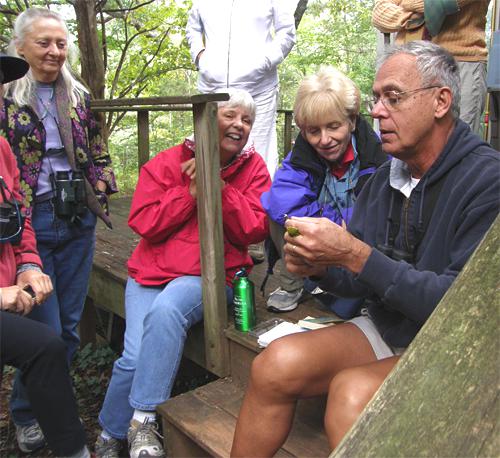
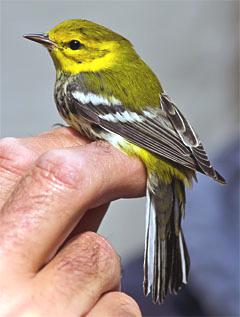 a long-time follower of our Hilton Pond natural history initiatives, recruited a group of folks for a Guided Field Trip that--thanks to good weather and well-placed mist nets--ended up being a concentrated exercise on how to capture, identify, and band wild birds. The Chapinites asked great questions and offered great answers during their three-hour visit, during which we got exceptionally close looks at numerous species such as our fourteenth-ever Black-throated Green Warbler (above right, photo by Sparkle Clark), a couple of Northern Cardinals, several interesting-to-compare Gray-cheeked and Swainson's Thrushes--plus previously banded Carolina Chickadees and Tufted Titmice. According to several follow-up e-mails we received, everybody went back to Chapin happy and ready to return for a later visit, and several participants even sent us photos to document an excellent day of bird banding, teaching, and learning. These kinds of experiences occur on a regular basis at Hilton Pond Center--open year-round (by appointment only) for Guided Field Trips for individuals and groups of all ages (what we call "K thru Gray"). For information about booking your own excursion, please see
a long-time follower of our Hilton Pond natural history initiatives, recruited a group of folks for a Guided Field Trip that--thanks to good weather and well-placed mist nets--ended up being a concentrated exercise on how to capture, identify, and band wild birds. The Chapinites asked great questions and offered great answers during their three-hour visit, during which we got exceptionally close looks at numerous species such as our fourteenth-ever Black-throated Green Warbler (above right, photo by Sparkle Clark), a couple of Northern Cardinals, several interesting-to-compare Gray-cheeked and Swainson's Thrushes--plus previously banded Carolina Chickadees and Tufted Titmice. According to several follow-up e-mails we received, everybody went back to Chapin happy and ready to return for a later visit, and several participants even sent us photos to document an excellent day of bird banding, teaching, and learning. These kinds of experiences occur on a regular basis at Hilton Pond Center--open year-round (by appointment only) for Guided Field Trips for individuals and groups of all ages (what we call "K thru Gray"). For information about booking your own excursion, please see 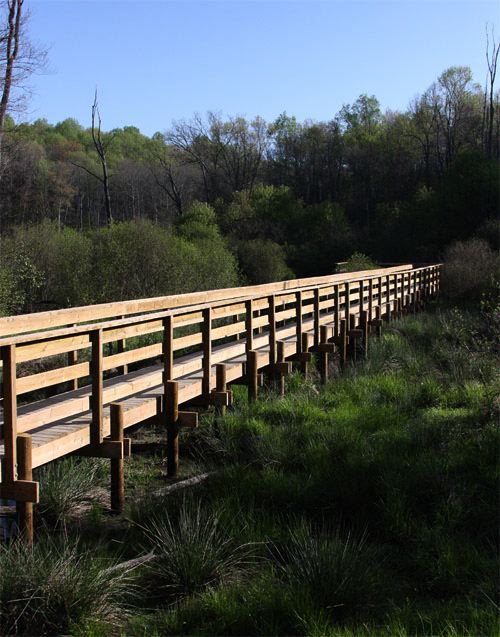
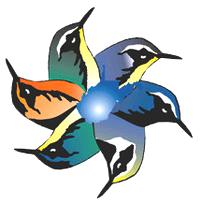 We travel north at least once a month to our "sister center" in the Mountain State to give presentations for students and the public, help with program design and fundraising, oversee construction of trails and an outstanding Wetlands Boardwalk (above), and perform other related tasks. We got involved with the group back in 2003 at the first New River Birding & Nature Festival (warbler-laden logo at left), a week-long event that each spring brings a hundred or more nature enthusiasts from all over North America for one of the country's top birding festivals. After nine years of spring successes, planners decided in 2011 to try offering a scaled-down autumn festival focused on learning to identify "confusing fall warblers" and migratory birds of prey.
We travel north at least once a month to our "sister center" in the Mountain State to give presentations for students and the public, help with program design and fundraising, oversee construction of trails and an outstanding Wetlands Boardwalk (above), and perform other related tasks. We got involved with the group back in 2003 at the first New River Birding & Nature Festival (warbler-laden logo at left), a week-long event that each spring brings a hundred or more nature enthusiasts from all over North America for one of the country's top birding festivals. After nine years of spring successes, planners decided in 2011 to try offering a scaled-down autumn festival focused on learning to identify "confusing fall warblers" and migratory birds of prey.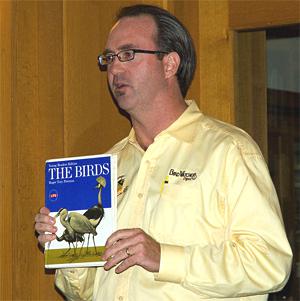 where we gorged on homemade chicken pot pie, Italian cream soda, and the best carrot cake ever. After stuffing themselves group members turned chairs and attention toward a projection screen set up by none less than Bill Thompson III (right), editor of Bird Watcher's Digest and long-time friend of the New River spring festival. Bill has traveled the world since childhood, accompanying his birder parents on nature-related trips--a passion he now shares with wife Julie Zickefoose and their two children. "Bill of the Birds" presents and guides every year at the spring festival, so he was a logical choice for opening night speaker at the new autumn event.
where we gorged on homemade chicken pot pie, Italian cream soda, and the best carrot cake ever. After stuffing themselves group members turned chairs and attention toward a projection screen set up by none less than Bill Thompson III (right), editor of Bird Watcher's Digest and long-time friend of the New River spring festival. Bill has traveled the world since childhood, accompanying his birder parents on nature-related trips--a passion he now shares with wife Julie Zickefoose and their two children. "Bill of the Birds" presents and guides every year at the spring festival, so he was a logical choice for opening night speaker at the new autumn event.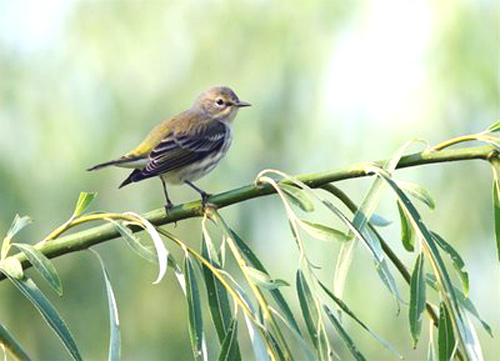
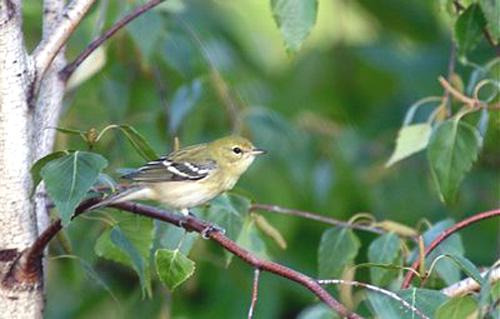
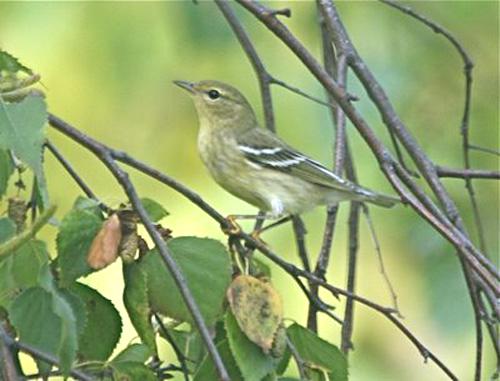
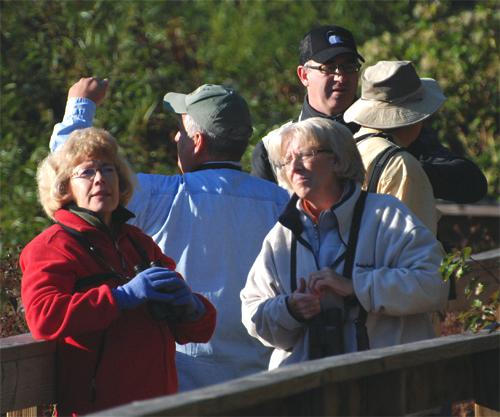
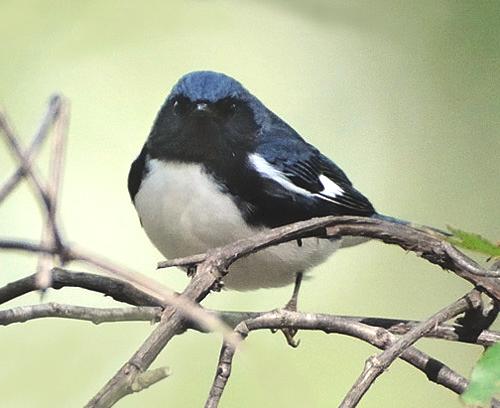
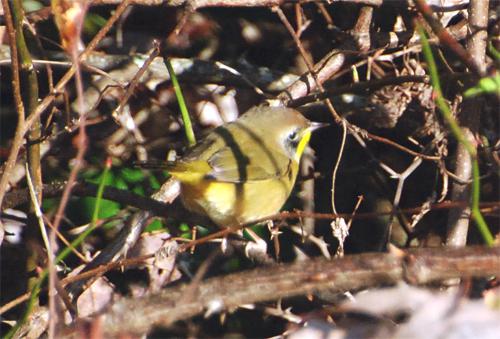
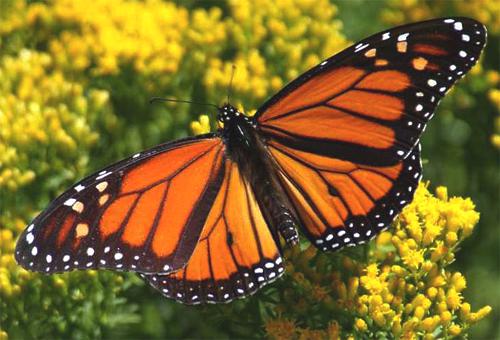
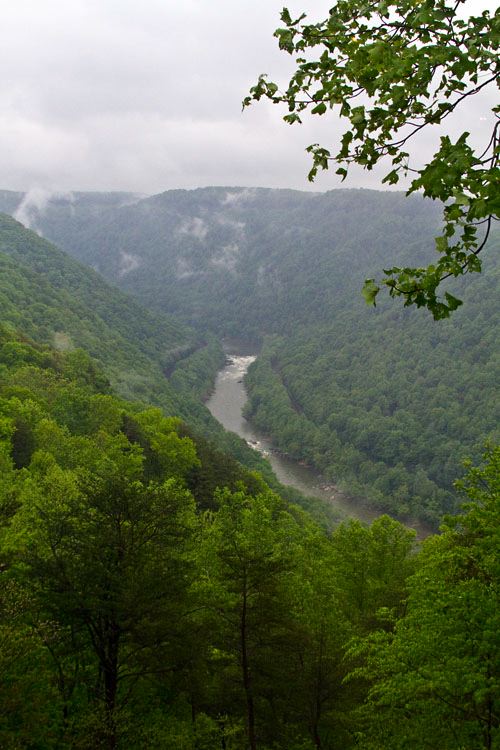

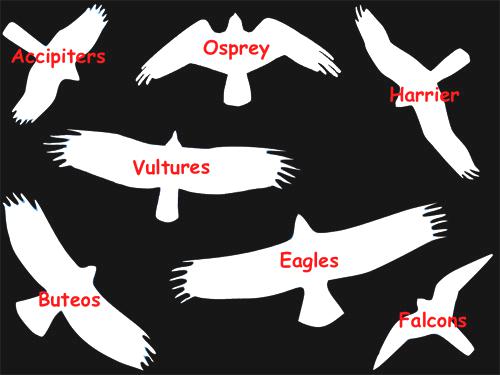
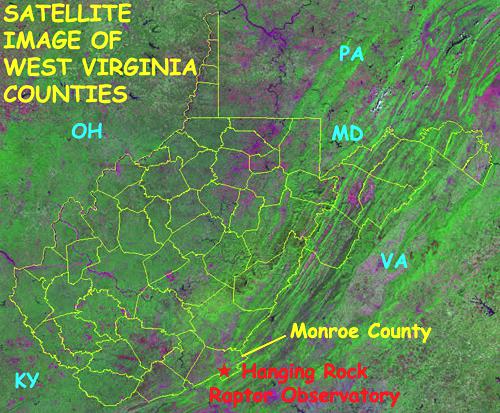
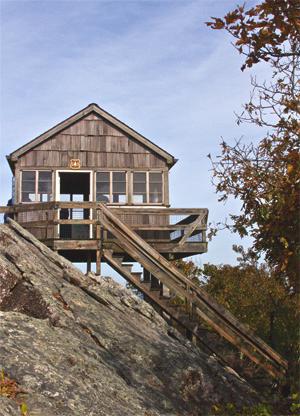 Monroe is the most southeasterly county in the state and one that borders Virginia's Shenandoah Valley Region. From there it was a short drive up the mountain to a gravel parking lot in Jefferson National Forest, a vast 690,000-acre expanse of mixed-use woodland and farms that covers much of western Virginia, two counties in Kentucky, and part of Monroe County. Slicing from northeast to southwest through the national forest is the eastern edge of the Appalachian Mountains, whose ridges and valleys run are a topographic wonderment in border counties of the Virginias. Our destination was the highest and most easterly of these ridges. With great anticipation and binoculars and cameras in hand the group headed out on the Allegheny Trail that climbs up Peters Mountain to Hanging Rock Raptor Observatory (above left), re-built in 1996 on the site of a former fire tower on top of the ridge.
Monroe is the most southeasterly county in the state and one that borders Virginia's Shenandoah Valley Region. From there it was a short drive up the mountain to a gravel parking lot in Jefferson National Forest, a vast 690,000-acre expanse of mixed-use woodland and farms that covers much of western Virginia, two counties in Kentucky, and part of Monroe County. Slicing from northeast to southwest through the national forest is the eastern edge of the Appalachian Mountains, whose ridges and valleys run are a topographic wonderment in border counties of the Virginias. Our destination was the highest and most easterly of these ridges. With great anticipation and binoculars and cameras in hand the group headed out on the Allegheny Trail that climbs up Peters Mountain to Hanging Rock Raptor Observatory (above left), re-built in 1996 on the site of a former fire tower on top of the ridge.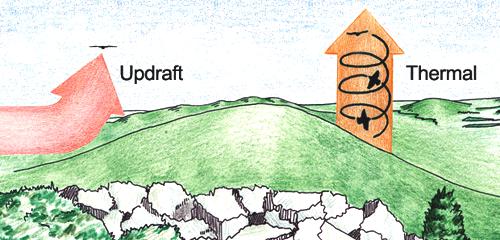
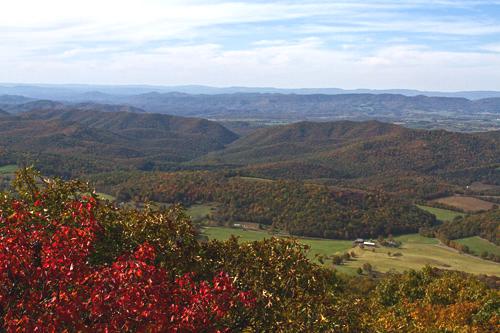
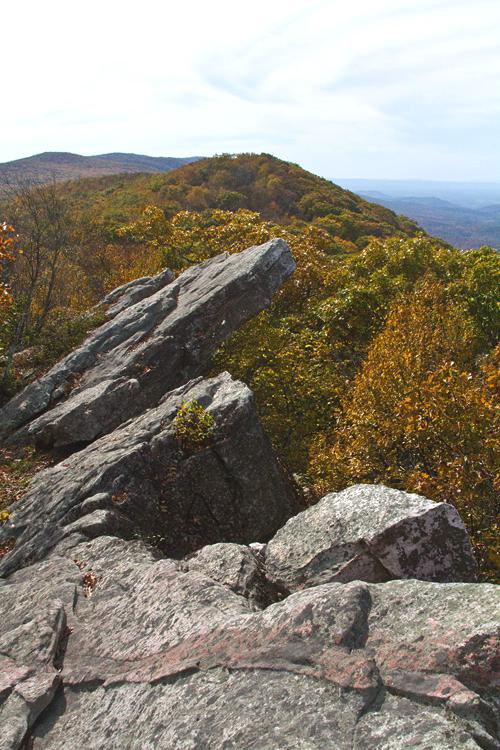
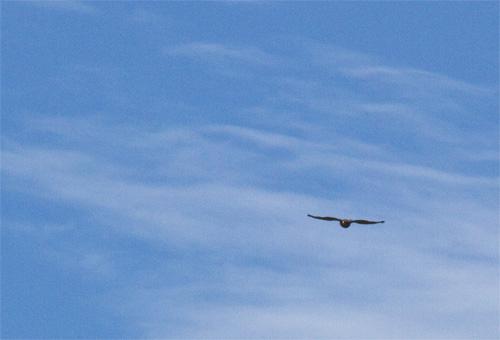
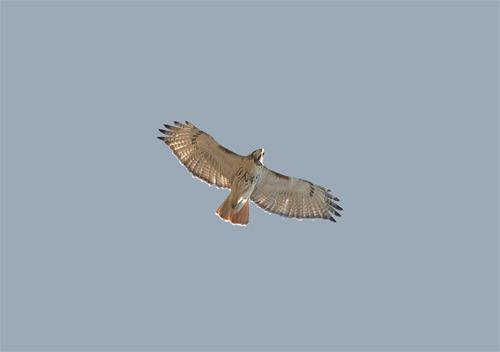
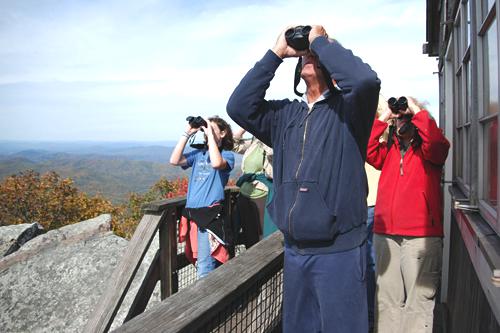
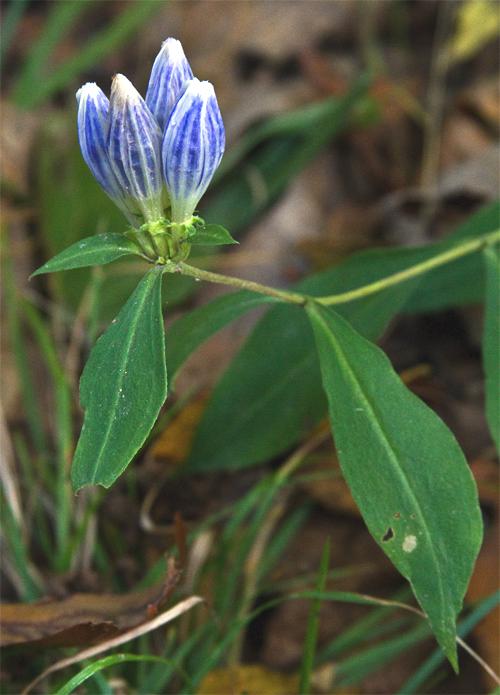
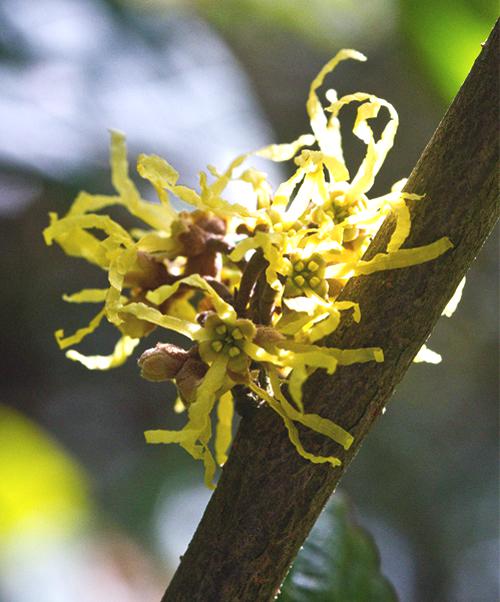
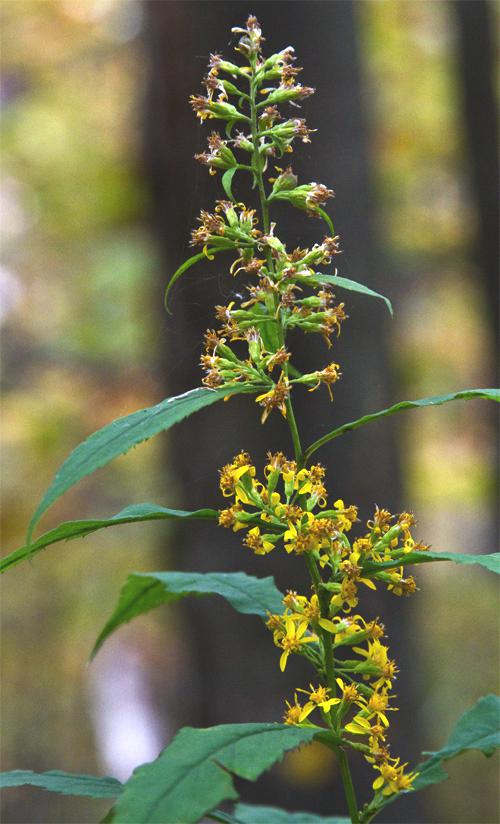
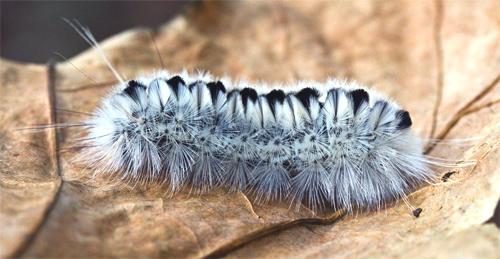
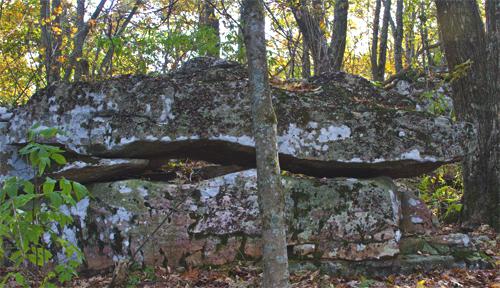
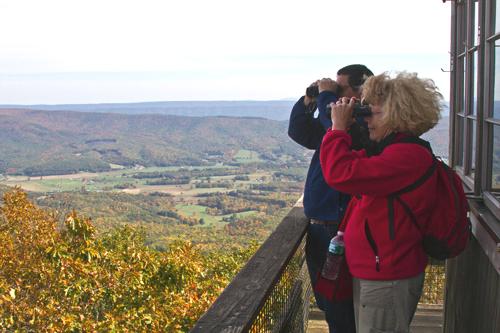

 Please report your
Please report your